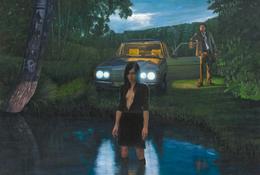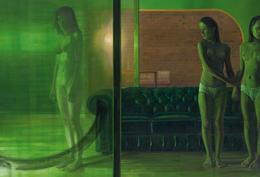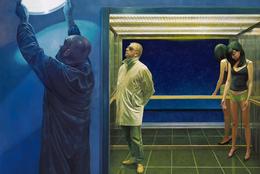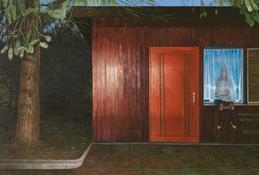Where the Shadows Dwell
The New York art-critic Carol Strickland stamped in 2006 for the first time the term of the Sottorealism. In this essay she gives explanations to several paintings of New Leipzig School painter Aris Kalaizis.
Lines from T.S. Eliot’s poem “The Hollow Men” seem tailor-made to describe the effect and achievement of recent paintings by Aris Kalaizis:
“Between the ideaAnd the reality
Between the motion
And the act
Falls the shadow.”
Kalaizis’ imagination occupies this hazy middle ground between fiction and fact, motion and inertia. His images shuttle between idea and reality, and, always, between these polarities falls the shadow. Gettersby (2007) demonstrates this approach. On the left a disheveled man emerges from a lit corridor, an emblem of arrested motion. He seems to come from the ordinary world of the harried commuter, rushing to catch a train. But in the midst of this familiar scene, Kalaizis injects the bizarre: the silhouette of a man, standing still, as if behind a scrim, suffused in lurid, hot-pink light. His shadow literally links the two figures, forming a visible connection as their elbows almost hook up.
The shadowy apparition is partly concealed behind Kalaizis’ trademark graffito, which is itself fraught with ambiguity. The scrawled lines, resembling a flower or butterfly, are a mark of self-expression and a symbol of natural beauty, but they also represent an aggressive act that defaces the purity of a wall. This pro-and-con vacillation is a hallmark of the German-Greek painter’s body of work. Nothing is ever purely one thing or the other. Every detail generates its opposite. Yet there is never a Hegelian synthesis, only a continuous dialogue between the polarities. Kalaizis objects to the audioguides that are so omnipresent these days, attached like barnacles to visitors’ ears at museum exhibitions. He prefers to think for himself, and he aims to entice his viewers to do the same. But he doesn’t want to make it easy. For this reason, he often gives nonsensical titles to his works, with made-up names like Gettersby or Psemata offering no clue or entry point into a work’s meaning.

What may seem like willful opacity is a challenge. And the paintings are so seductive, it’s impossible not to accept the challenge. By combining the seemingly normal with the overtly abnormal, he grabs your attention and draws you into the drama of the image. The scenes hover between the familiar and the unfamiliar. They’re so fraught with mystery, it’s impossible to resist the call to decipher the clues and seek an explanation. Yet Kalaizis frustrates this urge. No matter how diligently one collects the pieces, one can never assemble a satisfactory mosaic that gives a clear picture. The meanings are always multiple, in constant flux.
Take, for example, Bahren (2007). A woman whose expression is neutral stands in a pond, fully dressed, her shirt unzipped to partially reveal her breasts. Right away, we’re in Kalaizis territory, for this half-concealing, half-revealing motif is a favorite ploy. Although the water is dark, she’s illuminated by bars of light from a car’s headlamps, which form a constraining cage around her.
Standing beside the car on shore is a clothed man looking off into the distance with an abstracted expression. There seems to be no emotional connection between the two, yet the fact that the car is in this isolated location at night leads one to believe it’s a lovers’ lane. The candle-like flowers of a chestnut tree are shaped like an erect phallus, which lends a further frisson of sexuality. Carved initials on a tree trunk nearby could be lovers’ testimonials, but an ambiguous image that resembles an upside-down skull is also carved on the tree.
This couple, who do not seem to be coupled but rather uncoupled, are surrounded by the lush greenery of nature, another contrast to the sterility of their non-relationship. In the background, light breaks through dark clouds, but whether it’s the light of dawn on the waning light of sunset is unclear. Bahren suggests a complex narrative but refuses to settle into a coherent story. It’s like the yin and yang of constantly interpenetrating and interposing opposites. Much is visible, but much more invisible in the tale of these two people.
…combining the normal and abnormal in tableaux that radiate tension and conflict
The Green Room (2007) shows how charged is the space between figures and between figures and their surroundings. An adult woman stands nude on one side, enveloped in a glaze of green paint and framed by vertical and horizontal lines, like a doll in a gift box. Expressionless, she’s as passive and static as a statue. On the right is another of Kalaizis’ preferred motifs, the Doppelgänger. A young, nearly nude, girl stands, holding the hand of her double. One figure looks towards the adult, as if anticipating maturity, while her twin looks down and away, as if back towards childhood. You feel the girl is on the threshold of sexual maturity, half desiring entrance into the adult world and half clinging to the innocence of the past.

Although the child and adult are isolated spatially and make no eye contact, Kalaizis links them through pictorial means: a non-objective swoosh of black paint forms an inverse curve to the scrolled curve of a leather sofa that extends between the girl and the woman. A line of gold paint begins in the woman’s space and transforms from straight to curved as it extends to the shoulder of the Doppelgänger, who’s enveloped in the same eerie green light as the woman. The viewer is left to fill in the blanks.
This insistence on do-it-yourself interpretation defines Kalaizis’ approach. It’s as if he wishes the viewer to brood over the images as much as he has in composing them. His process of evolving a painting has been told before: how a spark of an idea seizes him, based on an observed landscape or locale. He photographs this embryonic setting and literally places the picture over his bed, to dream on it for weeks or months until a scene gradually emerges in his inner vision. He then populates the locale with figures and details, pared down to those considered absolutely essential to transmit the spirit of the place.
Although his craft is meticulous and he can paint illusionistic scenes with virtuosic exactitude, he has no desire to imitate reality. The setting is merely a launching pad for his flights of fancy, which go both high into the realm of the imaginary and deep into the unconscious, where fears and anxiety live. Perhaps for this reason, his paintings often seem charged with menace, shivering hints of the inexplicable.
It’s dangerous to try to catch a falling knife, but that’s just what he attempts, combining the normal and abnormal in tableaux that radiate tension and conflict. The outcome is always uncertain, yet it’s this irresolution that’s so gripping. And which makes prolonged contemplation of his work so rewarding.
…like the soul of drama, it radiates conflict, contradiction, and contrast
Another writer whose sensibility the works share is the British playwright Harold Pinter. His plays are so multivalent and elusive, they’ve given rise to the adjective “Pinteresque,” defined as “ full of dark hints and pregnant suggestions, with the audience left uncertain as to what to conclude.” The same might be said for Kalaizis’ The Double Man (2007).
In a dim room, a figure (a self-portrait of the artist) is fully clothed, tying his tie and looking upward, standing beneath a bright hanging lamp. On the other side of double doors stands the artist’s double, a half-clothed figure who defies reality, in that he’s suspended in mid-air, seemingly on a shadowy plane that points to the clothed figure (and links to his shadow). The ghostly figure leans forward, looking down (another opposite!) and holding what looks like a valise over his head. Behind him looms a colossal shadow, like a statue of Atlas with the weight of the world on his shoulders.
The ensemble suggests the physical and spiritual sides of humanity, with all their contrasting qualities like certainty and confusion, extroversion and introversion, society and solitude, joy and despair, light and dark. The shadows and figures, as well as the voids and solids in the picture, seem to have equal weight. The painting is both empty of conclusion and full of possibility. Like the soul of drama, it radiates conflict, contradiction, and contrast.

The Allies (2007) illustrates how Kalaizis uses painterly devices to push and pull the eye through the twists and detours of his visual language. The overlapping straight and curved lines lead you through the surface of the painting, like a map to the hidden treasure of its meaning. But the surface is also an arena for thwarting this linear progression. It twists the map of your mind from what you think you know to what’s unknown and unknowable. The path to enlightenment is never straightforward. Its trajectory always involves doubling back through murky, shadowy terrain in the search for meaning.
In this painting, the artist shines a harsh spotlight on his uplifted head, implying his own attempts at seeing clearly and reaching for illumination. Behind him are two isolated, alienated figures in ambiguous poses. A man wearing a jacket and dark glasses regards the wall of a garishly lit cubicle, turned away from a woman who inhabits the opposite corner of the stall. She looks down, her hands outstretched as if in entreaty. She’s scantily clad and her face is impassive, yet the slump of her head conveys sadness, a plea to which the man is oblivious. Straight lines entrap the two and, illogically, she’s mirrored at the rear but the man has no reflection, as if he’s invisible.
…Engaging the viewer to think, feel, react, and respond to his canvases is the difficult task he sets for himself
Kalaizis, like the English painter Francis Bacon, employs the architecture of a scene as a framing device, making form follow function. His lines seem to contain the human beings who inhabit the space, oppressive and threatening. Within the shared space, the figures appear static, melancholy, vaguely frightened, and drained of energy. Communication between them is non-existent, as if they’re mired in separate spheres and rectangles. The paintings, while setting up an atmosphere of bristling, psychological tension, conceal the cause and the outcome of the intense situation portrayed.
The Morning After (2006) is almost like the opening scene of a police drama – or the waking continuation of a nightmare. A young girl clothed in undergarments stands holding tightly to a woman, seemingly her mother, who’s fully clothed and ramrod straight, eyes closed and face betraying no emotion. The girl seems fearful, a supposition strengthened by the presence of a man kneeling in the foreground, with a stricken expression on his face. He regards his hands like a guilt-haunted Lady Macbeth, although no blood is visible on his fingers. The two females are framed in green light, and this green shadow spills onto the man. The walls alternate between slabs of soft lavender, acidic green, and a strong “white” light emanating from a refrigerator that spotlights the man. The refrigerator’s glow seems unearthly, like a spectral aura of mystery.
…Ugliness is something which absolutely needs to be added to the idea of beauty
In this painting, contrast reigns supreme: contrast between the two conjoined figures and the lone man, between their upright stance and his kneeling posture, and between their shadowed presence and his proximity to the source of harsh light. “Ugliness is something which absolutely needs to be added to the idea of beauty,” Kalaizis has said. And here he’s created an object of beauty out of terrifying ingredients.

In the Silence of the Night (2008) is a masterful example of a scene with familiar elements that radiates an aura of the uncanny. A driveway in the foreground leads to a wooden building lit by a harsh glare – perhaps of headlights? The door is resolutely closed, implying hidden secrets, but a rectangular window of blue light is open. A young girl sits on the outer edge of the windowsill, her upper body partly concealed by a translucent, white curtain. She looks down as if unaware of anyone approaching, and the gauzy white fabric makes her seem like a waiting bride. One has the impression she’s both inside and outside at the same time, poised on the edge of some adventure. Leipzig painter Kalaizis is adept at inventing images of transition, where figures seem on the brink of some momentous undertaking but, at the same time, are congealed in desperation or stasis.
The luscious color harmonies in this image and the sensual allure of the richly painted, overhanging spruce tree attest to Kalaizis’ technical skill as a painter. Yet even though capable of rendering a photo-realist representation of reality, he’s never content merely to reproduce the seen world.
…creating his own version of reality where the shadows dwell
Rather, he aims to uncover what’s unseen. And the way to access this buried domain is through allegory and fantasy. He blurs the boundary between the real and unreal, creating his own version of reality where the shadows dwell. This willful manipulation makes his art very demanding. It’s up to the viewer to dig beneath the surface, based on clues embedded in the image, like an archeologist looking for a hidden civilization. One can put the fragments together into a provisional interpretation, although the irrational reflections and illusions never jell into a fixed message.
Always, in his art, the colors, shapes, zones of light and dark, figures and their poses, simultaneously intersect, overlap, and stand in contrast to each other. Just when one feels on the verge of deciphering a narrative, its contours of meaning melt into shadows. Comfort and certainty are not his goals. Engaging the viewer to think, feel, react, and respond to his canvases is the difficult task he sets for himself.

©2008 Carol Strickland | Aris Kalaizis
Carol Strickland, Ph. D., born in 1946, is a freelance art critic who writes for a number of several newspapers and magazines. She is the author of "The Annotatet Mona Lisa (2007), a book on art history and architecture, among other publications. Strickland lives and works in New York City.